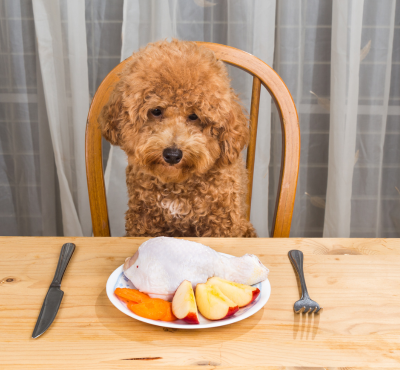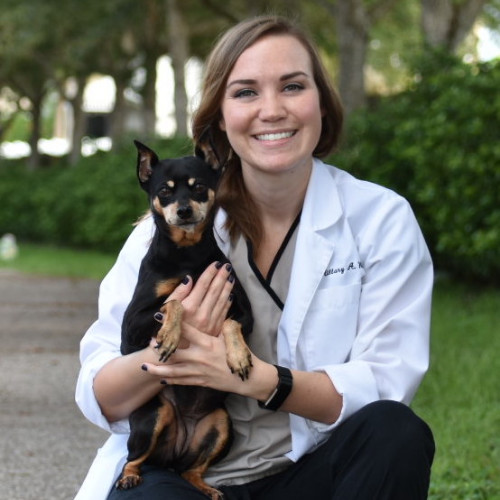Did your dog sneak into the trash and discover some raw chicken? While some pet owners might shrug off such an incident, it’s important to understand the potential dangers associated with raw chicken consumption in dogs and understand why not all types of meat are safe.
In this article, we delve into the possible risks, signs of poisoning, and steps to take if your dog has consumed raw chicken.

The Dangers of Dogs Eating Raw Chicken
The raw chicken diet trend in canine nutrition may be on the rise, but that doesn’t erase the potential risks that come alongside it. Bacteria such as E. Coli, Salmonella, and Campylobacter can lurk in raw chicken and pose a significant health risk to your dog.
- E. Coli: Escherichia Coli, or E. Coli, is a bacterium that commonly resides in the intestines of both humans and animals. While many strains of E. Coli are harmless, some can cause severe illness and symptoms such as severe diarrhea and vomiting.
- Salmonella: Salmonella is another common bacteria found in raw chicken. Dogs affected by Salmonella might show signs of lethargy, diarrhea, vomiting, fever, and decreased appetite 1. More severe cases could even lead to dehydration and shock.
- Campylobacter: Campylobacter infection, though less well-known, can also cause symptoms like diarrhea, vomiting, and abdominal pain.
How Much Raw Chicken is Dangerous for Your Dog?
The health impact after a dog ate raw chicken depends not only on the presence of bacteria but also on the quantity consumed relative to your dog’s size and weight. A smaller dog may experience more severe symptoms than a larger one after consuming the same amount of contaminated chicken. This is due to the higher bacterial load per kilogram of body weight in smaller dogs.
The Hidden Danger: Raw Chicken Bones
Ingesting bones poses a substantial risk for dogs consuming raw chicken. The popular perception of dogs savoring bones often obscures the severe hazards.
- Choking Hazard: Raw chicken bones, particularly smaller ones, can pose a choking hazard.
- Blockages: Even if your dog manages to swallow a chicken bone without choking, it can become lodged further down the digestive tract, causing a blockage, potentially leading to severe symptoms, including vomiting, decreased appetite, and constipation or difficulty defecating.
- Internal Damage: Splintered chicken bones can cause tears or perforations in your dog’s digestive tract, leading to internal bleeding and potentially life-threatening infections.
Recognizing Signs of Potential Food-borne Illness
It is crucial to closely observe your pet if they have consumed raw chicken. The incubation period, the time between ingestion and the appearance of symptoms, can vary depending on the specific pathogen involved. However, symptoms usually appear within 24 to 72 hours.

The following are some of the more specific signs and symptoms of potential foodborne illnesses:
- Diarrhea: Diarrhea is one of the most common signs of food-borne illnesses in dogs. This can range from loose stools to watery diarrhea. Be especially watchful for the presence of blood or mucus, which could indicate a more serious infection or internal injury.
- Vomiting: Vomiting accompanied by nausea, as evidenced by excessive drooling and swallowing. Repeated or severe vomiting can lead to dehydration, which can be critical, especially in puppies or smaller dogs.
- Decreased Appetite or Anorexia: A dog that has ingested contaminated food may show a sudden disinterest in food. If your pet refuses to eat for more than a day, it’s imperative to contact a veterinarian immediately.
- Lethargy: Dogs suffering from foodborne illnesses often display noticeable lethargy. They may seem less active or uninterested in their usual activities. This can be accompanied by weakness or even difficulty standing or walking.
- Signs of Abdominal Discomfort: Your pet might exhibit signs of abdominal discomfort, such as whining, restlessness, or pacing. You may also observe your dog hunched up or assume a ‘praying’ position, which can be indicative of abdominal pain.
Steps to Take After Your Dog Has Consumed Raw Chicken
Upon noticing any of these symptoms, it’s essential to take immediate action. The first step is to remove any remaining raw chicken that your pet might have access to, thereby preventing further ingestion.
If your dog ate raw chicken and shows any signs of potential food-borne illness, immediate veterinary intervention is necessary. Even if symptoms are not evident within the first 24 hours, it is still recommended to inform your vet about the situation.
A professional can provide appropriate advice based on the specific circumstances and the overall health condition of your pet. Provide your veterinarian with all the necessary information, including the amount of raw chicken your dog might have consumed and the specific symptoms observed.
Safe Alternatives to Raw Chicken
While some pet owners are drawn to the potential benefits of a raw diet for their dogs, the risks associated with feeding raw chicken make it crucial to consider safer alternatives.
- Commercially Prepared Raw Dog Food: These products are designed to mimic the benefits of a raw diet while minimizing the risk of bacterial contamination. They undergo stringent safety checks and are typically frozen or freeze-dried to ensure pathogen control.
- Cooked Chicken: Cooked chicken, free of seasonings and bones, can be a safe and nutritious addition to your dog’s diet. Cooking effectively kills bacteria, reducing the risk of foodborne illness. Canned chicken meat is also a safe alternative.
- High-Quality Dry or Wet Dog Food: Commercially prepared dry or wet dog foods are formulated to meet all your dog’s nutritional needs. These foods are cooked under high temperatures to kill potential pathogens, ensuring they are safe for consumption.
Always consult with a veterinarian or a certified pet nutritionist when considering dietary changes to ensure your dog’s nutritional needs are adequately met.
The Importance of Dietary Safety and Prompt Action in Dog Health
It is essential to underscore the importance of providing a safe and nutritious diet for your dog. While some risks, like the consumption of raw chicken, can be mitigated, it’s always vital to be vigilant and aware of potential dangers in your dog’s diet.
In cases of accidental ingestion of raw chicken or when symptoms of foodborne illnesses manifest, prompt veterinary intervention can make a significant difference in your pet’s health outcome. As a pet owner, your dog’s health and wellbeing are in your hands. Thus, informed decisions about their nutrition and safety should always take center stage.
Citations
Evaluation of the Risks of Shedding Salmonellae and Other Potential Pathogens by Therapy Dogs Fed Raw Diets in Ontario and Alberta. (2008)
Frequently Asked Questions About Dogs Eating Raw Chicken
-
Yes, it’s advisable to consult your vet if your dog consumes raw chicken, even if they don’t immediately show symptoms, to discuss potential risks and necessary precautions, but make sure to take your dog to the vet if they begin to show symptoms.
-
Symptoms of sickness from eating raw chicken can typically appear within 24 to 72 hours, depending on the type and amount of bacteria present
-
Not all raw chicken will cause food poisoning, but there’s a risk due to potential bacterial contamination, including pathogens such as E. Coli, Salmonella, and Campylobacter.
-
The danger isn’t necessarily tied to a specific amount of raw chicken; even small quantities can be harmful if the chicken is contaminated with harmful bacteria. It’s generally safer to avoid feeding your dog raw chicken.

